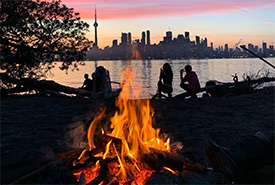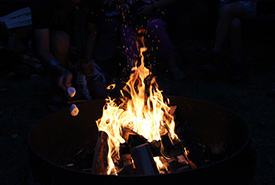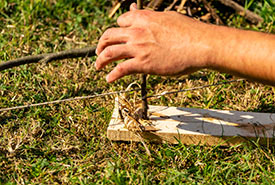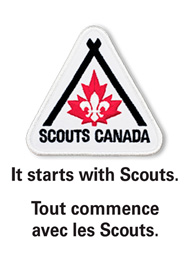Heard it from a Scout: Light a campfire like a Scout

Toronto Island campfire (Photo by Scouts Canada)
Whether you are going on an easy day hike or a week-long backpacking adventure, being able to build a fire is an important survival skill. While you may plan to bring a lighter or matches, it’s always best to be prepared with fire-starting techniques and knowledge to get a fire going if your lighter or matches get lost or wet.
A fire is important not only for cooking food or boiling water, it also helps you stay warm and call for help using smoke signaling in case of an emergency. Knowing a variety of fire-starting methods will help you be prepared like a Scout — no matter the weather!
Add a spark to your fire with these five helpful tips.
1. Oxygen, fuel source, heat
When choosing where to build your fire, take the terrain into consideration. Start by moving anything flammable — leaves, wood or your backpack and tent — away from the campsite’s designated fire pit (if it has one). If it doesn’t, build the fire on a durable surface like a rock, dirt or sand to prevent scorching the earth. Be sure you are not too close to trees while still within a sheltered area, in case it rains.
Next, collect your fuel source. This can be dry leaves, twigs or larger pieces of wood from deadfall. Other great fuel sources to keep in your fire-starter kit are dryer lint and cotton balls coated with Vaseline, as they sustain a flame longer than plain cotton balls.
To generate the heat required for your fire, a lighter or matches are great fire-starter options. Ensure that the lighter is full before you head out on your adventure, and keep your matches in a waterproof container. In the winter, this container should be metal, as plastic containers can easily crack in the cold.
Once your fuel is ignited, successively add larger pieces of your fuel source to build your fire. Avoid smothering your fire. Feed the fire kindling and small twigs at first and slowly create a teepee shape with larger sticks as the fire catches, and then logs when the heat is consistent. Blowing gently at the base of the fire will help the flames grow more quickly.
Related blog posts
2. Flint and steel
Another common way to start a fire is using flint and steel. For this method, repeatedly strike the steel (such as the steel blade on a pocket knife) on the flint to create sparks, which will then ignite your fire starter. Be sure your fuel — small twigs, dryer lint or Vaseline cotton balls — is small, dry and readily ignitable, as these sparks will not catch on large pieces of wood.
3. Steel wool and battery
Alternatively, use steel wool and a battery to light a fire. A 9V battery works best; however, in a pinch a phone battery could work as long as it has enough charge. To make a fire, brush the battery on the steel wool until the steel wool starts to spark or catch on fire. This method works extremely well, but be careful not to transport the two items together or a fire could catch from them jostling in your backpack.
4. Curved glass

Knowing a variety of fire-starting methods will help you be prepared like a Scout. (Photo by Scouts Canada)
Start a campfire with equipment you may already have at home, such as eye glasses, a camera lens, binoculars or magnifying glass. With help from the sun, concentrate the beam of sunlight onto a very small surface area of your fuel source. Don’t hesitate to take apart your binoculars or camera in order to get a good lens to work with, especially if your survival depends on it. Also, be sure that the sunlight is strong and direct for this method.
5. Bow drill

To light your fire with a bow drill, find a plank of pine wood, a straight pointy stick, a curved stick and a piece of string (a shoelace will work). (Photo by Scouts Canada)
To light your fire with a bow drill, find a plank of pine wood, a straight and pointy stick, a curved stick and a piece of string (a shoelace will work).
Tie the string from one end of the curved stick to the other end, creating a bow. Loop the string around the pointy stick and saw the bow repeatedly back and forth on the pine plank to create heat. The friction will result in small sparks, which can be used to ignite your fire. Note that this method can be tiring and ineffective if you are not able to saw quickly or long enough to generate sufficient heat. Try practising this method at home before relying on it during your next camping trip.
For a visual step-by-step guide, check out this helpful National Geographic video.
As an experienced Scout, I have tried each of these methods with great success. Besides the matches, the battery and steel wool work the best with very little effort. It is a wise idea to practise various methods of fire starting in a safe environment before you head out on your adventure, so you can determine what you like best and what works best for your needs and situation.
To help ensure your next adventure is successful and safe, be prepared and expect the unexpected!
"Heard it from a Scout" is written by members of Scouts Canada’s Youth Spokesperson program. This post was authored by Quinn McPherson.


